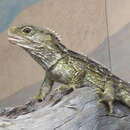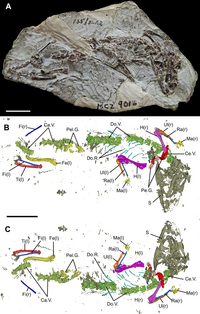en
names in breadcrumbs


Other Physical Features: ectothermic ; bilateral symmetry
Key Reproductive Features: gonochoric/gonochoristic/dioecious (sexes separate)
Sphenodontidae is a family within the reptile group Rhynchocephalia, comprising taxa most closely related to the living tuatara of the genus Sphenodon. Historically the taxa included within Sphenodontidae have varied greatly between analyses, and the group has lacked a formal definition.[2] Cynosphenodon from the Early Jurassic of Mexico has consistently been recovered as a close relative of the tuatara in most analyses, with the clade containing the two often called Sphenodontinae.[2] The herbivorous Eilenodontinae, otherwise considered part of Opisthodontia, is also sometimes considered part of this family as the sister group to Sphenodontinae. Sphenodontines first appeared during the Early Jurassic, and are characterised by a complete lower temporal bar caused by the fusion of the quadrate/quadratojugal and the jugal, which was an adaptation for reducing stress in the skull during hard biting.[3] Like modern tuatara, members of Sphenodontinae were likely generalists with a carnivorous/insectivorous diet.[4]
 Skeleton of Navajosphenodon from the Early Jurassic of North America, one of the oldest sphenodontines.
Skeleton of Navajosphenodon from the Early Jurassic of North America, one of the oldest sphenodontines. Illustration of the skull of Navajospenodon in lateral view, showing closed temporal bar (bottom right)
Illustration of the skull of Navajospenodon in lateral view, showing closed temporal bar (bottom right) Sphenodontidae is a family within the reptile group Rhynchocephalia, comprising taxa most closely related to the living tuatara of the genus Sphenodon. Historically the taxa included within Sphenodontidae have varied greatly between analyses, and the group has lacked a formal definition. Cynosphenodon from the Early Jurassic of Mexico has consistently been recovered as a close relative of the tuatara in most analyses, with the clade containing the two often called Sphenodontinae. The herbivorous Eilenodontinae, otherwise considered part of Opisthodontia, is also sometimes considered part of this family as the sister group to Sphenodontinae. Sphenodontines first appeared during the Early Jurassic, and are characterised by a complete lower temporal bar caused by the fusion of the quadrate/quadratojugal and the jugal, which was an adaptation for reducing stress in the skull during hard biting. Like modern tuatara, members of Sphenodontinae were likely generalists with a carnivorous/insectivorous diet.